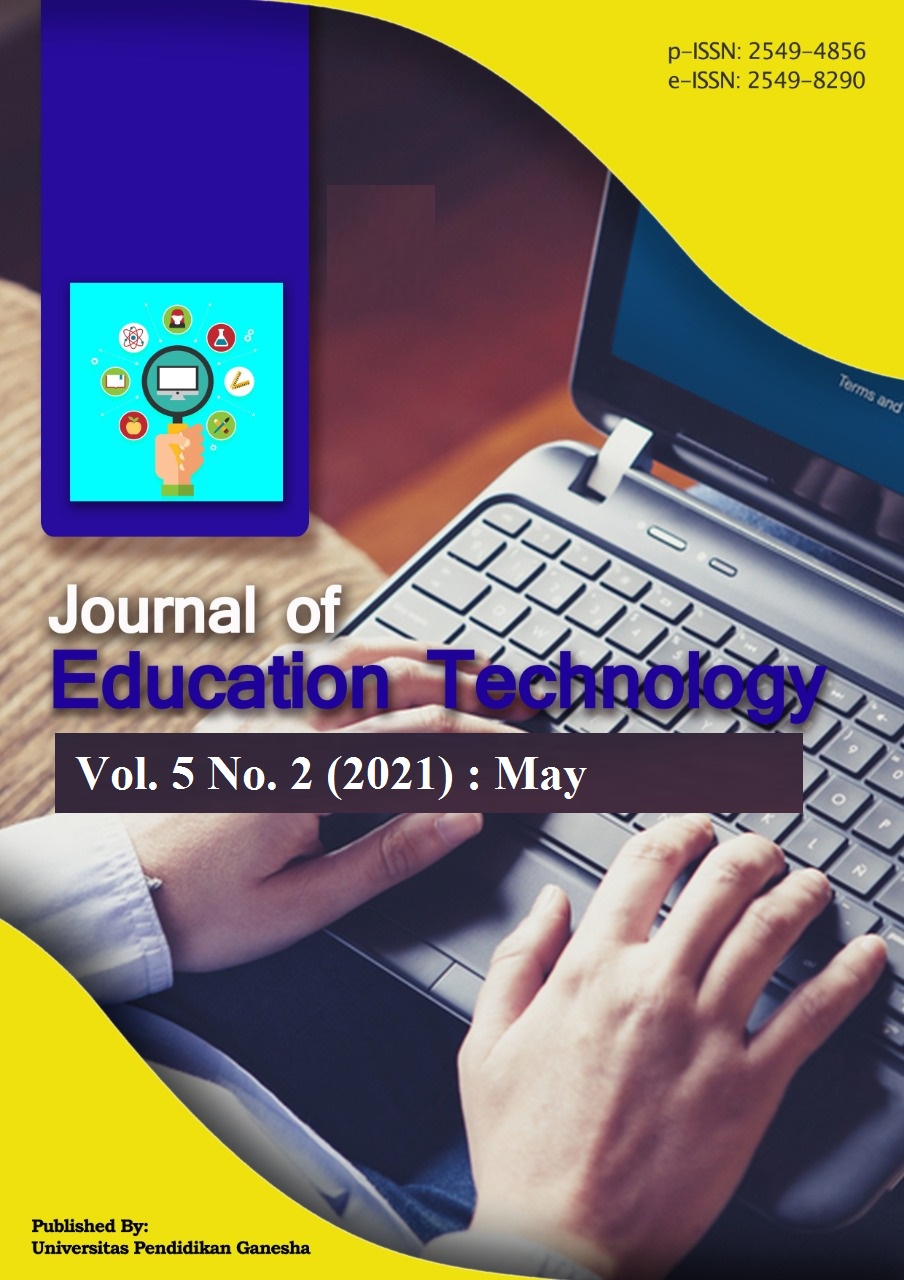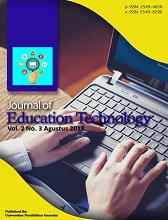Automotive Engineering Drawing Learning: Effective Online Learning Using Autocad Application
DOI:
https://doi.org/10.23887/jet.v5i2.33197Kata Kunci:
Online Learning, Automotive Engineering Drawing, Autocad ApplicationAbstrak
Learning outcomes are not satisfactory and student learning motivation is low. As a result, students cannot fully master the competency of automotive engineering drawings which are learning outcomes.. This study aims to analyze the effect of using autocad software to improve students' online learning outcomes of automotive engineering drawings. This quasi-experimental study used a pretest-posttest design and a control group. All class X students of the engineering and motorcycle business expertise program in two vocational schools became the population in this study. The sample used in this study amounted to 112 students who were divided into 4 classes in two vocational schools. The data collection technique was carried out using tests with multiple choice objective test instruments and drawing worksheets. The collected data were analyzed using descriptive statistics and inferential statistics with t test. The results of the t test obtained tcount = 9.703 with ttable at a significance level of 5% = 1.986. These results show the value of tcount> ttable, so that it accepts Ha and rejects H0. Thus it is concluded that the use of autocad software in online learning automotive engineering drawings has a significant effect on improving student online learning outcomes.
Referensi
Abidah, A., Hidaayatullaah, H. N., Simamora, R. M., Fehabutar, D., & Mutakinati, L. (2020). The Impact of Covid-19 to Indonesian Education and Its Relation to the Philosophy of “Merdeka Belajar.” Studies in Philosophy of Science and Education. https://doi.org/10.46627/sipose.v1i1.9.
Alan, C., Saul, E. W., Mathews, S., & Makinster, J. (2005). Teaching and Learning Strategies for The Thinking Classroom. The International Debate Education Association.
Anugrahana, A. (2020). Hambatan , Solusi dan Harapan : Pembelajaran Daring Selama Masa Pandemi Covid-19 Oleh Guru Sekolah Dasar. Scholaria: Jurnal Pendidikan Dan Kebudayaan, 10(3), 282–289. https://ejournal.uksw.edu/scholaria/article/view/4033.
Aryana, I. G. A., Dewi, L. J. E., & Nugraha, I. . P. (2019). Pengembangan Media Pembelajaran Berbasis Video Animasi Software Solidworks 2014 Dan Adobe Flash Cs3 Pada Mata Pelajaran Teknologi Dasar Otomotif (Tdo) Materi Motor Bakar. Jurnal Pendidikan Teknik Mesin Undiksha, 7(3), 99–110. https://doi.org/10.23887/jptm.v7i3.26512.
Billett, S. (2011). Vocational Education: Purposes, Traditions and Prospects. Springer. https://doi.org/10.1007/978-94-007-1954-5.
Clark, L., & Winch, C. (2007). Vocational Education : International Approaches, Developments and Systems. Routledge.
Darling-Hammond, L., Flook, L., Cook-Harvey, C., Barron, B., & Osher, D. (2020). Implications for educational practice of the science of learning and development. Applied Developmental Science, 24(2), 97–140. https://doi.org/10.1080/10888691.2018.1537791.
Darmawan, E. S., & Khairudin, M. (2017). Development of an Interactive Learning Media to Improve Competencies. 1st International Conference on Technology and Vocational Teacher, 102, 24–27. https://doi.org/10.2991/ictvt-17.2017.5.
Falivene, L., Cao, Z., Petta, A., Serra, L., Poater, A., Oliva, R., Scarano, V., & Cavallo, L. (2019). Towards the online computer-aided design of catalytic pockets. Nature Chemistry. https://doi.org/10.1038/s41557-019-0319-5.
Furqon, Z., & Pramono, J. (2017). Gambar Teknik Otomotif (Tyas (ed.); II). Penerbit Andi.
Gusti, F. R., Haryadi, H., & Purnawan, P. (2018). Penerapan Media Interaktif Toleransi Dan Suaian Untuk Meningkatkan Hasil Belajar Siswa Pada Pembelajaran Gambar Teknik. Journal of Mechanical Engineering Education, 5(1), 35–41. https://doi.org/10.17509/jmee.v5i1.12617.
Hamalik, O. (2014). Kurikulum dan Pembelajaran (1st ed.). PT Bumi Aksara.
Johnson, D., & Maclean, R. (2008). Teaching: Professionalization, Development and Leadership. Springer Science+Business Media B.V.
Keiler, L. S. (2018). Teachers’ roles and identities in student-centered classrooms. International Journal of STEM Education. https://doi.org/10.1186/s40594-018-0131-6.
la Velle, L., Newman, S., Montgomery, C., & Hyatt, D. (2020). Initial teacher education in England and the Covid-19 pandemic: challenges and opportunities. Journal of Education for Teaching, 46(4), 596–608. https://doi.org/10.1080/02607476.2020.1803051.
Li, Y. (2013). Computer aided design based on visual FORTRAN and AutoCAD. In Advanced Materials Research (Vol. 628, pp. 245–248). https://doi.org/10.4028/www.scientific.net/amr.628.245.
Liguori, E., & Winkler, C. (2020). From Offline to Online: Challenges and Opportunities for Entrepreneurship Education Following the COVID-19 Pandemic. Entrepreneurship Education and Pedagogy, 3(4), 346–351. https://doi.org/10.1177/2515127420916738.
Madyatmadja, E. D., Abdurachman, E., Gaol, F. L., Pudjianto, B. W., & Hapsara, M. (2018). Citizen recommendation for social media-based government application development: A design science approach. Journal of Computer Science, 14(10), 1318–1328. https://doi.org/10.3844/jcssp.2018.1318.1328.
Malik, R. S. (2018). Educational Challenges In 21st Century And Sustainable Development. Journal of Sustainable Development Education and Research, 2(1), 9–20. https://doi.org/10.17509/jsder.v2i1.12266.
Nurtanto, M. (2016). Interpretasi Gambar Teknik: Mehamami Proyeksi Amerika dan Eropa dengan Mudah dan Penerapan Gambar pada Kelistrikan Otomotif (1st ed.). Parama Publishing.
Onyema, E. M., Eucheria, N. C., Obafemi, F. A., Sen, S., Atonye, F. G., Sharma, A., & Alsayed, O. A. (2020). Impact of Coronavirus Pandemic on Education. Journal of Education and Practice, 11(13), 108–121. https://doi.org/10.7176/jep/11-13-12.
Priambodo, E., & Nuryanto, A. (2020). Pengembangan Materi Ajar Berbantuan Edmodo pada Mata Pelajaran Gambar Teknik Manufaktur untuk SMK. Jurnal Dinamika Vokasional Teknik Mesin, 5(2), 145–153. https://doi.org/10.21831/dinamika.v5i2.34803.
Ranabumi, R., Rohmadi, M., & Subiyantoro, S. (2017). Improving Students’ Writing Short Story Skill through Time Token Learning and Video Media. Journal of Education and Learning (EduLearn), 11(4), 439–445. https://doi.org/10.11591/edulearn.v11i4.6808.
Rindu, I., & Ariyanti, A. (2017). Teacher’s Role in Managing the Class during Teaching and Learning Process. Script Journal: Journal of Linguistic and English Teaching, 2(1), 83–100. https://doi.org/10.24903/sj.v2i1.77.
Septian, D., & Handayani, K. D. (2017). Penerapan Model Pembelajaran Kooperatif Tipe Practice Rehearsal Pairs dengan Autocad 3D pada Mata Pelajaran Menggambar Dengan Perangkat Lunak di SMKN 2 Surabaya. Jurnal Kajian Pendidikan Teknik Bangunan, 2, 237–240.
Setyawan, R. B., & Munoto, M. (2016). Implementasi Model Pembelajaran Langsung Menggunakan Software Autocad pada Kompetensi Dasar Menggambar Rencana Instalasi Penerangan di SMK Raden Patah Mojokerto. Jurnal Pendidikan Teknik Elektro, 05, 951–956.
Sinaga, R. M., Trisnaningsih, T., Pujiati, P., & Sudarmansyah, D. (2019). Development of Learning Media Based on Mobile Learning Applications. Jurnal Pendidikan Progresif, 9(1), 50–58. https://doi.org/10.23960/jpp.v9.i1.201907.
Stone, J. K., & Pate, A. N. (2020). The impact of COVID-19 through the eyes of a fourth-year pharmacy student. American Journal of Pharmaceutical Education. https://doi.org/10.5688/ajpe8146.
Sudira, P. (2017). Tvet Abad XXI : Filosofi, Teori, Konsep, dan Strategi Pembelajaran Vokasional. UNY PRESS.
Sugianto, M. (2010). Merancang Perkantoran dan Perumahan Menggunakan Autocad (I). Penerbit Andi.
Sugiyono. (2017). Metode Penelitian Kuantitatif, Kualitatif, dan R&D. Alfabeta.
Thisgaard, M., & Makransky, G. (2017). Virtual learning simulations in high school: Effects on cognitive and non-cognitive outcomes and implications on the development of STEM academic and career choice. Frontiers in Psychology. https://doi.org/10.3389/fpsyg.2017.00805.
Toquero, C. M. (2020). Challenges and Opportunities for Higher Education amid the COVID-19 Pandemic: The Philippine Context. Pedagogical Research, 5(4), 1–5. https://doi.org/10.29333/pr/7947.
Van Nuland, S. E., & Rogers, K. A. (2016). The anatomy of E-Learning tools: Does software usability influence learning outcomes? Anatomical Sciences Education. https://doi.org/10.1002/ase.1589.
Ziden, A. A., Zakaria, F., & Othman, A. N. (2012). Effectiveness of AutoCAD 3D Software as a learning support tool. International Journal of Emerging Technologies in Learning, 7(2), 57–60. https://doi.org/10.3991/ijet.v7i2.1906.
Unduhan
Diterbitkan
Cara Mengutip
Terbitan
Bagian
Lisensi
Authors who publish with the Journal of Education Technology agree to the following terms:
- Authors retain copyright and grant the journal the right of first publication with the work simultaneously licensed under a Creative Commons Attribution License (CC BY-SA 4.0) that allows others to share the work with an acknowledgment of the work's authorship and initial publication in this journal.
- Authors are able to enter into separate, additional contractual arrangements for the non-exclusive distribution of the journal's published version of the work (e.g., post it to an institutional repository or publish it in a book), with an acknowledgment of its initial publication in this journal.
- Authors are permitted and encouraged to post their work online (e.g., in institutional repositories or on their website) prior to and during the submission process, as it can lead to productive exchanges, as well as earlier and greater citation of published work. (See The Effect of Open Access)


















